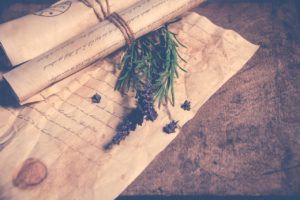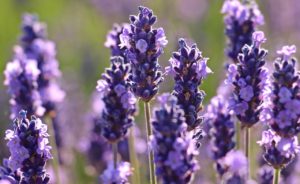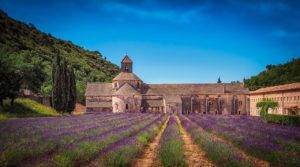Lavender’s Long History
B.C.
For many centuries, lavender has enjoyed popularity for its alluring fragrance and for its medicinal qualities. Lavandula dentata was first cultivated on the Arabian peninsula, and other species spread from Greece across Europe. Lavender species might also have originated in the Cape Verde Islands and the Canary Islands off the west coast of Africa.
Thousands of years ago, Egyptians and Phoenicians used the herb in perfumes and during mummification. When Egyptian King Tutankhamen’s (1341-1323 B.C.) tomb was opened by Howard Carter in 1922, claims were made that the scent of lavender could be detected.
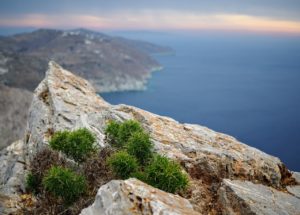
Greek traders introduced lavender around 600 B.C. to the Hyères Islands, off the southern coast of France, and to Europe from there. Ancient Greeks used it for insomnia and backache, and in public baths.
 Other healing qualities of lavender were recorded in the 3rd century B.C., when Greek physician/philosopher Theophrastus (c. 372-287 B.C.) wrote of them in Concerning Odours.
Other healing qualities of lavender were recorded in the 3rd century B.C., when Greek physician/philosopher Theophrastus (c. 372-287 B.C.) wrote of them in Concerning Odours.
Cleopatra (69-30 B.C.), Queen of Egypt from 47-30 B.C., was able to temporarily preserve her kingdom from Roman rule. As the story goes, she used lavender to win the love of Roman generals Julius Caesar (100-44 B.C.) and Mark Antony (83-30 B.C.).
Upon defeat by Augustus Caesar (63 B.C.-14 A.D., first Roman emperor from 27 B.C.-14 A.D., and heir of Julius Caesar) and Cleopatra’s death by suicide, Egypt then became a Roman province.
Early A.D.
Mary is said to have used lavender when Jesus (4 B.C.-30 or 33 A.D.) was an infant and again when he was crucified. Both the Bible and, later, William Shakespeare’s (1564-1616) work The Winter’s Tale, refer to the herb as “spikenard”. Ancient Greeks called lavender “nard” or “nardus”, apparently after Naarda, a city in Syria where it was sold.
Pliny the Elder (23-79), Roman naturalist and encyclopedist, described relief from “women’s problems” attributed to lavender. His great work, Naturalis Historiae, is composed of 37 volumes, describing natural sciences from agriculture to mineralogy to zoology. Dioscorides, the Greek physician under Nero (37-68), collected herbs and, in 77, wrote about their uses in De Materia Medica.
When the Romans invaded England in 43, they used the lavender they brought with them for bathing, cooking, and giving scent to the air. The Romans and the early French believed in its antiseptic properties, and used it to treat infections and to heal wounds.
It is no surprise, then, that lavender derives from the Latin root lavare, meaning “to wash”. And when the Romans departed England around 410, this plant was left behind, growing in gardens around monasteries.
It’s Debatable
Much information online refers to the introduction of lavender to England as late as the 16th century. But as important as this herb was in Roman culture, and because other references claim that they did indeed bring it with them when they invaded England, I will leave it there…unless I find information that clarifies the debate.
From the Middle Ages Forward
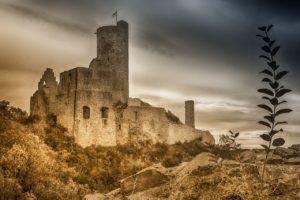
During the Dark Ages, from the late 400’s to 1100, lavender wasn’t used much outside the monasteries. An edict issued by the Holy Roman Empire in 812 ordered monks to grow vegetables, medicinal herbs, trees, and flowers. Lavender was grown at Merton Abbey, near the center of production in Mitcham, in Surrey, England. According to records from 1301, Merton Priory sold lavender to raise money for King Edward I (1239-1307).
Medieval and Renaissance women who worked by taking in laundry used the herb to scent it when washing and also when drying the laundry on top of lavender shrubs. In 12th century England, washerwomen using the herb in this manner were called “lavenders”. Incidentally, the word “laundry” derives from the same root, the Latin lavare.
Monks cultivated it in monasteries as a medicinal herb during the Middle Ages (in European history, approximately 500-1350). A German nun named Hildegard of Bingen (1098-1179) used lavender water with vodka and gin for relief from migraine. And French King Charles VI (1368-1422) slept with lavender-filled pillows.
From the Renaissance
Fit For a Queen Or a King
English King Henry VIII (1491-1547) destroyed the stone monasteries and their medicinal herb gardens in the 1500’s during the religious purges. Because this plant is not native to the area, remaining specimens of lavender were found primarily in private gardens.
King Henry’s daughter (with Anne Boleyn), Queen Elizabeth I (1533-1603), enjoyed lavender conserve, a type of jam, and fresh flowers every day. She sought relief from migraines by drinking an herbal tisanne containing lavender.
King Louis XIV (1638-1715) of France bathed in scented water. Around this time, lavender was used to treat headaches, nervous conditions, insect bites, mad dogs, and snake bites. And if people needed their passions stirred, they just tied some stems to the bed post!
And For the Rest Of Us
Merchants traveling along the Silk Road, from central Asia to Europe, inadvertently carried the Black Death with them. Bubonic plague spread across Europe from 1346 to the early 1350’s, killing one-third to possibly 60% of the entire population.
Infected fleas on rats transmitted the Yersinia pestis bacterium to people initially through flea bites. But modern researchers now think transmission was airborne, particularly among crowded populations. Outbreaks of the plague were treated with lavender as an antiseptic, but its efficacy is questionable, especially against such a virulent microbe.
Lavender Makes Good Business Scents
Sixteenth century glove makers in Grasse, France, used lavender to scent their wares. I can’t judge the accuracy of the claim, but it was said that those who made or wore the gloves were spared the agony of plague and cholera.
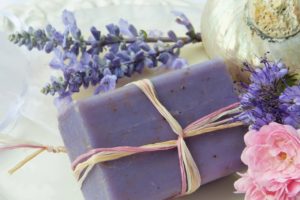
The Shaker community was the first to commercially cultivate lavender in the area now known as the United States and Canada, in the 1600’s. They used it to treat hyperactivity, flatulence, insomnia, and to fight bacterial and fungal infections. Their products that sold in distant markets included candles, cleaning products, soaps, and treatments for bee stings, migraines, burns, restless sleep, and skittish horses.
In another European epidemic in 1664-5, many died from the Great Plague. Lavender sold for high prices and was in demand for its supposed ability to ward off infection and to repel insects. People wore bundles of the herb on their wrists. Burglars of the ill took precautions by washing in Four Thieves Vinegar, containing lavender, garlic, and vinegar, to prevent infection. And those criminals who were caught and sentenced to digging graves also washed in the vinegar.
Seventeenth century herbalists John Gerard and Nicholas Culpeper wrote about the benefits of lavender. Gerard prescribed it for palsy. A few decades later, in 1652, Culpeper recommended it, in The English Physician, “for all the grief and pains of the head”.
Ornamental Use
In 17th century Ireland, lavender was planted as a low clipped lawn. Later, in the mid 1860’s in County Down, Sir Arthur Rawdon’s Moira Castle maintained an acre of lavender lawn. John Reid, in 1766, recommended lavender as an ornamental walkway edging in The Scots Gardener.
The Victorian Era

Queen Victoria.
Both Queen Victoria and Queen Elizabeth I, hundreds of years before her, used herbal products supplied by Yardley and Company of London.
Britain’s Queen Victoria (1819-1901) popularized lavender from its use as a deodorant, and floor and furniture cleaners. The Queen appointed Miss Sarah Sprules “Purvey of Lavender Essence to the Queen”, and used it everywhere and as a cure-all.
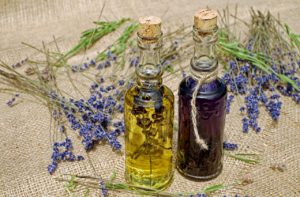 As a strewing herb on floors, it gave out a fresh scent when walked upon. Women sold bundles of lavender, called Tussie mussies, on the city streets. The scent became synonymous with purity and cleanliness.
As a strewing herb on floors, it gave out a fresh scent when walked upon. Women sold bundles of lavender, called Tussie mussies, on the city streets. The scent became synonymous with purity and cleanliness.
In 19th century Provence, France, lavender treated dizziness, nerves, convulsions, stomach ailments, infections, palsy, and repelled fleas and other insects.
Lavender is still used in dried flower arrangements, pot pourri (flowers and buds), and sachets (for fragrance and to deter moths). Bath products, candles, and perfumes sold today attest to lavender’s enduring qualities.
Too Much Lavender?
Lavender’s overuse contributed, consequently, to loss of its popularity in the early 1900’s. It also became associated with “old ladies”, although during World War I, medics dressed soldiers’ wounds with it.
And then, in the 1920’s, French perfumer Rene Gattefosse severely burned his arm. He immediately plunged it into a vat of lavender oil, the story goes, and experienced immediate pain relief and, according to some, rapid healing. His book, Aromatherapie, describes applications for wounds and other uses derived from essential oils, and gave rise to…you guessed it…aromatherapy!
In the Medical Establishment
Whatever your beliefs—whether lavender’s popularity is due to its use as a panacea or as a wonderfully fragrant plant—it is beautiful in a sunny garden and it attracts bees, butterflies, and other pollinators.
There are only a few scents that come close to lavender on my list of favorites. But, on one of the “favorite smells” lists online, this scent rated #49! And “petrol” rated…#1! Bacon, freshly-baked bread, rain, cookies in the oven, and mowed grass made the top 10 in some of those lists. But…49th?!
Caution!

The U.S. National Institutes of Health recommends that pregnant or lactating women not use lavender on their skin or take it internally, because the side effects are unknown. For sensitive people, it can cause skin irritations, and can be toxic if consumed.
In prepubertal boys, gynecomastia, an enlargement of the breasts due to hormonal imbalances, can be caused by topical lavender products.
One research study claimed that attaching a pad dipped in lavender oil to the neckline of clothing reduced the risk of falling by 43% among nursing home residents.
Testing for its use in treating cankersores and insomnia resulted in insufficient evidence for its efficacy…
…But let me tell you a little story
One spring day at the garden center, I was working on lavender topiaries and large specimens—reshaping, cutting back, repotting, and removing all the dead leaves. The scent was just wonderful. It took a couple of hours to clean up all the plants, and then it was lunch time.
As always, I spent the time in my truck, reading and listening to the news while enjoying my lunch. Well…that day was the closest I had ever come, in the past 4 decades, to falling asleep while at work. I had to fight to stay awake!
Normally skeptical of proclaimed powers of plants, I believe this one—that the scent of lavender can induce sleep! No wonder it has been found in bath products for thousands of years.
Edible Lavender
Lavender has been used fairly extensively over the centuries, in conserves, teas, vinegars, and pastries. One of my herb books describes lavender as “an acquired taste”. I made lavender tea, once. Only once.
Apparently, L. a. ‘Munstead’ is the most popular variety for cooking and baking, for its sweeter fragrance and “citrusy notes”. Those seeking new culinary experiences might find lavender in salads, dressings, pasta, sauces, and desserts. If I remember correctly, it was at the Olney Farmers’ and Artists’ Market, in Maryland, where, years ago, I purchased a lavender bud and lemon poundcake that was delicious.
The Lavender Genus
Lavender is a member of the mint family, Lamiaceae, and is related to basil, thyme, rosemary, Swedish ivy (Plectranthus), ajuga, Phlomis, and all the salvias, including sage. Their lipped flowers appear in whorls, on spikes carried above the foliage. Flower colors range from white and pink, to blue, lilac, violet and blackish purple. Some species in the family have yellow flowers.
The stems of plants in this family are usually, but not always, square in cross-section. Lavender’s resemblance to rosemary has confused many gardeners, but the scent distinguishes one from the other.
There are 47 known species in the genus Lavandula. Leaves are generally simple (with a smooth, or “entire” margin) or dentate (with a toothed margin), although some species have pinnate leaves (L. buchii, from the Canary Islands). Leaves and other parts are covered in trichomes, the fine hairs (the indumentum) from which essential oils are harvested. L. lanata (from Latin lanaius), the woolly lavender, is covered in woolly hairs.
Most gardeners associate this genus with silver or gray foliage, but it includes some green-leaved species as well. Also available are variegated cultivars, such as ‘Platinum Blonde’, whose leaves are edged in creamy white.
Lavender From Seed
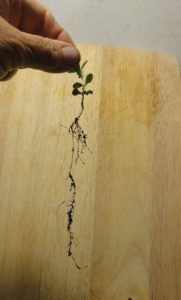
‘Ellagance Purple’ seedling.
Lavenders are small and shrubby in their growth habit, and qualify as woody perennials or as sub-shrubs.
Some will bloom in the first season when grown from seed, and, where they don’t survive the winter, would be considered annuals. I used to grow a variety called ‘Lady’, which had a powerful scent.
A new English lavender called ‘Blue Spear’ will sprout in 2 to 3 weeks from seed, after first being chilled for a week in the freezer. It will perennialize in zone 5 or 6, but can be grown as an annual flowering plant in colder regions. Seeds have to be started very early, though, or the previous fall, for blooms from late spring through summer. ‘Blue Spear’ is an upright plant, growing 11″ to 14″ tall and a bit narrower than that.
***Update***: This summer, I’m growing a variety of lavender from seed that blooms the first year if the seeds are started early in the season. ‘Ellagance Purple’ has dense spikes of deep purple flowers. So far, they look healthy in their 2½” pots, but I’m not sure they’ll have enough time to bloom this year. Photo shows how long the roots are compared to the stem. 7/20/2022
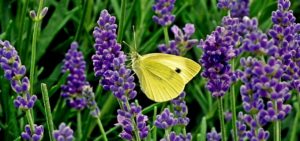
Perennial Species
Cross-pollination among the species and varieties gives rise to more variation. Cuttings taken from desirable plants (asexual or vegetative propagation), however, assure the grower that all the young cloned plants will look the same. Many newer cultivars are under plant patent protection, and may not be propagated without authorization from the patent holder.
Their common names also vary widely. The English types are well-defined, but when it comes to French or fringed, Greek, Italian, or Spanish, there doesn’t seem to be universally accepted agreement concerning the species they’re assigned to. When shopping for plants, refer to the name of the cultivar (‘Hidcote’, ‘Provence’, etc.) to avoid confusion.
Lavandula angustifolia
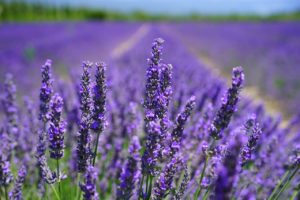 Zones 5-8. Formerly L. officinalis. Commonly called English lavender, this species grows well there but is native to France, Spain, and Italy. It is used more often in cooking than other lavenders, due to its lower camphor content. This species’ essential oils are considered superior to those of other species. Earlier blooming than lavandins, generally.
Zones 5-8. Formerly L. officinalis. Commonly called English lavender, this species grows well there but is native to France, Spain, and Italy. It is used more often in cooking than other lavenders, due to its lower camphor content. This species’ essential oils are considered superior to those of other species. Earlier blooming than lavandins, generally.
Varieties include:
- ‘Blue Spear’: zones 5 or 6 to 8 or 9. 11″-14″ tall, upright growth; deep blue substantial flowers, will flower first year from seed.
- ‘Ellagance Ice’: compact; large silver-white-light bluish flowers all summer.
- ‘Ellagance Purple’: zones 5-7; deep purple flowers on full spikes, blooming first year from seed.
- ‘Hidcote’: 12″-18″ tall; tightly budded stems; flowers deep purple.
- ‘Jean Davis’: 18″ tall; light pink flowers.
- ‘Melissa’: 24″ tall; pale pink to white flowers late spring to early summer.
- ‘Muntsead’: heat, sun, and humidity tolerant; 12″-18″ tall; late spring to early summer flowers from pale blue to shades of purple.
- ‘Platinum Blonde’ (‘Momparler’): zone 5b. To 18″ tall, culinary. Creamy white leaf margins.
- ‘Royal Velvet’: 2′ to 2 1/2′ stems; velvety purple/navy blue flowers that retain color when dried.
- ‘Sweet Romance’: 12″-18″ tall; purple flowers early summer to fall; a Proven Winners cultivar.
Lavandula x intermedia
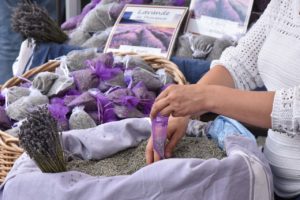
Zones 5-8. Often called Lavandin or Dutch lavender, this species is a cross between English lavender (L. angustifolia) and spike lavender (L. latifolia). Flowers have abundant nectar, and contribute to the sought after monofloral honey. These interspecific hybrids, denoted by the lower case “x” in the species name, are sterile and cannot set viable seed.
Varieties include:
- ‘Fred Boutin’: to 3 1/2′ tall. Late summer light blue blooms.
- ‘Grosso’, also called ‘Fat Spike’: about 3′ tall and wide; very fragrant; medium violet blue flowers. Grower Pierre Grosso (1905-1989) discovered this variety in the Vaucluse district of France. It has a very high oil content, and is disease resistant.
- ‘Hidcote Giant’: to 3 1/2′ tall. Dense, dark purple flowers, dries well.
- ‘Phenomenal’: zones 5-9; grows 2′ to 4′ tall and wide. ‘Phenomenal’ is more heat, humidity, and drought resistant than others. Introduced by Peace Tree Farms, 2012.
- ‘Provence’: from southwest France; foliage grows 2′ tall with very tall spikes of pale purple flowers in early summer to early fall; culinary, and commercially grown for the perfume industry. One of my favorites for scent and for tall, see-through flower spikes.
- ‘Seal’: 4′ to 5′ tall! Strong fragrance, late summer blooms.
- ‘Thumbelina Leigh’: zones 5 or 6 to 9. A dwarf English lavender, growing only 6″ to 12″ tall, medium blue flowers. This selection comes from New Zealand.
- ‘White Spike’: to 3 1/2′ tall. Nicely contrasting white flowers, mid summer. Culinary.
Lavandula dentata
Zones 8-9. French or fringed lavender grows about 3′ tall; toothed edges (dentata, from Latin for tooth), light woolly texture; narrow spikes of long-lasting purple flowers beginning in late spring; from the Mediterranean region, Atlantic islands, Arabian peninsula.
Lavandula stoechas
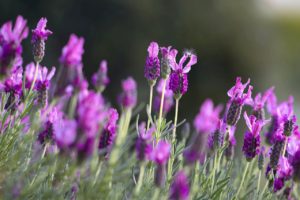 Zones 8-9. (Pronounced stee′-kiss; [“oe” has long “e” sound, as in “amoeba”, and Greek “ch” has a hard “k” sound.] Derived from the Greek stoichas for “in rows”.) French, Italian, or Spanish lavender is a compact grower; feathery petals at tip of inflorescence, sometimes called “Butterfly lavenders”.
Zones 8-9. (Pronounced stee′-kiss; [“oe” has long “e” sound, as in “amoeba”, and Greek “ch” has a hard “k” sound.] Derived from the Greek stoichas for “in rows”.) French, Italian, or Spanish lavender is a compact grower; feathery petals at tip of inflorescence, sometimes called “Butterfly lavenders”.
From France, Spain, Portugal, Italy, Greece; considered invasive in Victoria, Australia since 1920. Can self-seed. This was probably the species commonly grown in ancient Rome and Greece. Eucalyptus fragrance.
Varieties include:
- ‘Dark Eyes’: 2′ tall. Purple-red flowers May to autumn if deadheaded.
- ‘Kew Red’: zones 8 to 11. Red-violet blooms with deep pink bracts at tip. From southern Spain. Introduced by Kew Gardens, 1999.
- ‘Otto Quast’: 2′, prune for fullness. Reddish-purple flowers with deep pink bracts at tip.
- ‘Silver Frost’ (L. angustifolia x lanata): 2′ to 3′ tall, lax stems. Heavily felted silver foliage.
Lavandula pedunculata
Zones 9-10. Also known as Lavandula stoechas subspecies pedunculata. Spanish or French lavender has flowers high above the foliage, and long narrow petals on tip of flower; from Iberia, western Turkey, Morocco.
Photograph above: field of lavender at Notre-Dame de Sénanque Abbey, southeast France, in the Vaucluse district of Provence near the village of Gordes. Established by Cistercian monks in 1148.
Headings
Page 1: Lavender’s Long History, B.C., Early A.D., From the Middle Ages Forward, From the Renaissance (Fit For a Queen or a King, And For the Rest of Us, Lavender Makes Good Business Scents), The Victorian Era, Too Much Lavender?, In the Medical Establishment (Caution!, …But let me tell you a little story), Edible Lavender, The Lavender Genus (Lavender From Seed), and Perennial Species (L. angustifolia, L. x intermedia, L. dentata, L. stoechas, L. pedunculata)
Page 2: How To Grow Lavender (On Location, Light, Soil, How To Improve Drainage, Lime and Gypsum, Shopping for Lavender, How To Plant, Watering, To Mulch Or Not To Mulch, Fertilizer, Pruning, Growing Lavender In Pots, Azalea and Standard Pots, Freezing Temperatures, Heeling In, Growing Lavender Indoors)
